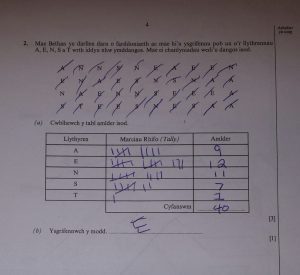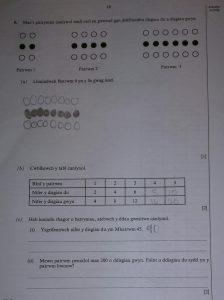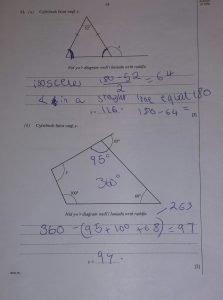Very quick post!
If you are doing any form of data work, here is a great website to discuss bad graphs.
My GCSE class loved it. The image above was also a head-scratcher – how can you explain what is going on?

Very quick post!
If you are doing any form of data work, here is a great website to discuss bad graphs.
My GCSE class loved it. The image above was also a head-scratcher – how can you explain what is going on?
Hands up all those who have challenged an underperforming teenager and got any of the following replies:
“I’ll do it with my tutor”
“Why aren’t we revising <unrealistic topic>?”
“It’s okay, I’ve got a tutor”
“It doesn’t matter what I do in class, I’ll do it with X”
“I don’t need to revise fractions (even though they can’t do them)”
“My tutor says this work is too easy for me”
“I don’t want to revise solving equations, I can’t do them”
“I’ve been doing cosine rule with my tutor (not even on the tier they are doing)”
“I’ve never done this (yes, you have but you talked through it every time we did it)”
“My mum says my tutor says I should be doing Higher”
“My tutor wants past papers”
Now don’t get me wrong, I know some amazing tutors – they know their maths, they are up to date with curriculum changes and they make a real difference. I also teach amazing kids who try their best all the time.
What really irritates me is the students who use tutors as an excuse for laziness and the tutors who teach complex topics but fail to reinforce the basics. So to combat this issue I’ve put together this PowerPoint – it got the message through to the students I was worried about in Year 11.
What should you revise (ppt)
I’ve been at a meeting in the Manchester Chamber of Commerce today and I was fascinated by how sympathetically the building has been renovated and preserved. The plasterwork, tiling, glasswork and carving demonstrated exquisite use of shapes, symmetry and tessellation. Here are a few images that you could use as discussion starter:
Just think of all the shape related problems you could set from each image!
If I had £1 for every time I heard ‘I don’t get it!’, I could probably buy a new (modestly sized) car. That phrase is banned in my classroom. What does ‘get’ mean? What is ‘it’? Did you actually read the question?
And there we have it: reading the question.
Today’s little life skill strategy can work for all levels of literacy – because you don’t need any! I’ve taught a lot of students who just shut down when they see wordy questions and don’t look at the big picture – literally. There can be a really obvious diagram and they will skip the question. They just don’t try!
Now as you may be aware, I’m based in Wales in the UK. For those outside the UK, Wales is a principality within Great Britain. Although everyone speaks english, the traditional mother tongue is welsh – it’s particularly spoken in the North/West of the country. If you attend a welsh language school, you can do all your exams in welsh. A GCSE is called a TGAU.
But why am I telling you this?
Well, this means that the WJEC/CBAC exam board publishes their exam papers in welsh and english. Identical papers, different languages. I teach over the border in England, where only one or two students per year can speak welsh. This is where it gets interesting …
I went through a welsh language ‘Mathemateg’ paper and picked out the questions which involved diagrams – I also picked out the matching English questions so I was clear on the questions (not a native welsh speaker, just a learner). I gave my GCSE class the Welsh questions and told them to figure out what was going on. After the initial disbelief they had a really good go at the questions. Their comments included:
‘Well, it’s obvious it’s a tally chart’

‘Just fill in the table with the numbers from the pattern’

‘That’s got to be a special type of triangle’ (answer isn’t correct, but idea was)

‘Just use angles in a triangle to work it out’

I was impressed – they were constructively arguing about questions and covering diagrams in good maths. When we went over the questions they were telling me how easy it was, yet the week before they’d skipped questions like the angle problem in an assessment! I explained why I’d done it and told them they didn’t need to keep the worksheets as I’d made my point. I was stunned by the number of students who wanted to take them home to show their parents – they were proud of their problem solving – 16 year olds wanting to show off their Maths skills!
This idea can be used with any bilingual exam board or any language that you speak that the students don’t. It’s a good tool for getting over ‘question blindness ‘ and literacy confidence issues too.
These are the exam papers I used:
If you look at the web addresses there is one digit difference to differentiate between the languages, meaning if you go on the WJEC english language website you can find the welsh equivalent by swapping a 0 for a 5 in the second to last digit.
Just a quick resource share today!
I’ve been doing functions with my GCSE class as part of the new curriculum and I’ve gone down the algebra route. I could have started with graph drawing like the parallel class did, but I know my class – drawing and accuracy are not their forte. We made brilliant progress with substituting into functions and even composite functions went smoothly. I wasn’t happy with the textbook resources on manipulating functions so I put together a step by step resource, including a basic skills recap:
Manipulating functions (docx)
Manipulating functions (pdf)
I also thought my class needed a little hand holding for inverse functions. There are many ways to do this, but the method I used was designed to allow the class to access the topic with teacher input verbally and on the board.
Inverse Functions worksheet (docx)
Inverse Functions worksheet (pdf)
Hope these help!
Oh and you can even use them as A-Level recap tools.
Updated (19:53): To fix typo on Inverse functions worksheets
I don’t know about you, but going over higher level questions (eg A-Level) after a test can be a frustrating time. The students never seem to fully engage because they think they know it all – even though they do get things wrong! What if I could offer you a way to review the test and incorporate an understanding of exam board mark schemes?
Image credit: www.sri.com
Preparation
Set Up
Task
I did this activity with a Year 12 group whilst reviewing an A-Level paper and it was a such a better use of time. The students were more engaged and I could interact with the class on a much more productive level.
Here is a neat little starter photograph (click on the image to enlarge) – get the mini whiteboards at the ready!
Possible questions
If you can’t read the data clearly, the prices are: £45, £30, £22.50, £13.50, 70 euros